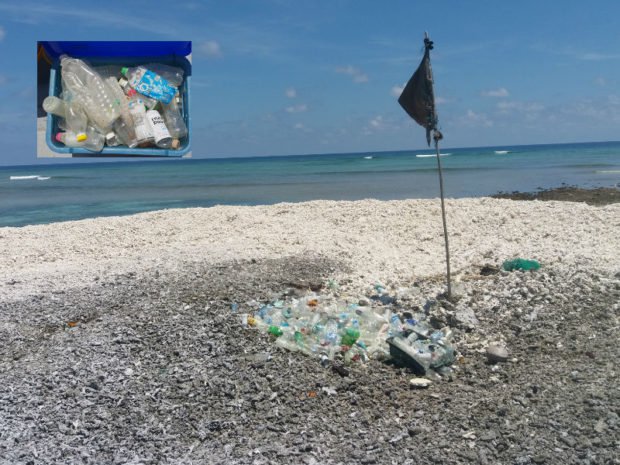Researchers from the University of the Philippines’ Marine Science Institute (UP MSI) embarked on a marine science expedition last month. They sailed to the Kalayaan Island Group in the West Philippine Sea with the goal of gathering information on its biodiversity. What they found was the exact opposite of what they anticipated.
(LOOK: Single-use plastics might soon be banned in the Philippines)
Instead of being welcomed by clear waters the group was shocked to see the area littered with plastic waste and floating trash — especially because the area they visited was a considerable distance away from inhabited islands. The islands they studied were at least a day’s trip away from the nearest city, Puerto Princesa. So the waste they found both drifting in the sea and being washed ashore had traveled quite some ways in the waters.
Photo from Deo Florence Onda AND Kevin Labrador of UP Marine Science Institute
The team reports collecting around 5 crates of trash from the area, which they plan to further investigate. Common items included in the waste were plastic bottles, cigarette packs, discarded fishing equipment, rubber slippers and fluorescent lamps for some reason. Labels on the objects marked their origins as the Philippines, China, and Vietnam, showing how far the damage of human waste spreads.
Deo Florence Onda, the team’s chief scientist, explains that this situation further proves the connectivity amongst marine ecosystems and how that’s become dangerous in the wake of human destruction. The garbage we improperly throw, or that is illegally shipped to our shores, begins to infect our waters and that infection continues to spread out.
(Read: 7 Products that are Made Out of Recycled Plastic)
According to Onda, “those are things that you wouldn’t expect to be there. We have such rich biodiversity in the area, but you also have this problem, this threat that accumulates over time.” The harm of the waste isn’t as simple as it dirtying the waters. Rather, they transport organic pollutants across the ocean as well as result in the consumption of plastic by marine life.
The toxins which pollute the ocean change its oxygen levels and endanger the survival of sea creatures. Garbage sometimes act as carriers of non-indigenous species and organisms, in turn forcibly shifting ecosystems and threatening its functions. When this waste is broken down it is then likely to be consumed by any number of creatures, from fishes to turtles. Plastic ingestion causes severe digestive problems and actually contributes to the death of around 100,000 marine mammals each year.
These are only some of the ways in which human waste has been so harmful to marine life. Effects to these extents make it easy to see why the discovery of trash created such a heavy disturbance. Kevin Labrador, a graduate student part of the expedition, further explains: “For a place [as far away] as that, we wouldn’t expect anything like this […] It really indicates that the problem is transboundary. Even if it’s already far away, our activities still impact these ecosystems.”
(60 billion sachets and 17.5 billion plastic bags are thrown each year in the Philippines)
Wilfred John Santiañez, an assistant professor of UP MSI, warned against other threats to the health of the Kalayaan Island Group reefs. Craters, pounded corals, and bleached surfaces all pointed towards the deterioration of the surrounding shoal. These damages are likely to have been caused by cyanide fishing and the warming of ocean waters spurred on by climate change. Relentless human activity in the areas, such as building artificial islands, could have been detrimental as well.
Thankfully, the Kalayaan Island Group is currently being considered as a marine protected area. Additionally, the Supreme Court has already issued a writ of kalikasan for a number of its areas, which “provides protection of one’s Constitutional right to a healthy environment.” Taken together, the two create opportunities for the State to effectively manage this marine environment.
What do you think can be done about this to improve the marine environment?





